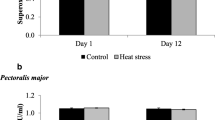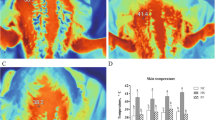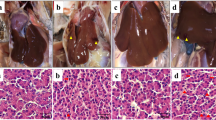Abstract
Rising temperatures are severely affecting the mortality, laying performance, and meat quality of duck. Our aim was to investigate the effect of acute heat stress on the expression of heat shock proteins (HSPs: HSP90, 70, 60, 40, and 10) and inflammatory factors (nitric oxide synthase (iNOS), cyclooxygenase-2 (COX-2)) and antioxidant enzyme activity (superoxide dismutase (SOD), malondialdehybe (MDA), catalase (CAT), total antioxidant capacity (T-AOC)) in livers of ducks and to compare the thermal tolerance of Pekin and Muscovy ducks exposed to acute heat stress. Ducks were exposed to heat at 39 ± 0.5 °C for 1 h and then returned to 20 °C for 1 h followed by a 3-h recovery period. The liver and other tissues were collected from each individual for analysis. The mRNA levels of HSPs (70, 60, and 40) increased in both species, except for HSP10, which was upregulated in Muscovy ducks and had no difference in Pekin ducks after heat stress. Simultaneously, the mRNA level of HSP90 decreased in the stress group in both species. Morphological analysis indicated that heat stress induced tissue injury in both species, and the liver of Pekin ducks was severely damaged. The activities of several antioxidant enzymes increased in Muscovy duck liver, but decreased in Pekin duck. The mRNA levels of inflammatory factors were increased after heat stress in both duck species. These results suggested that heat stress could influence HSPs, inflammatory factors expression, and the activities of antioxidant enzymes. Moreover, the differential response to heat stress indicated that the Muscovy duck has a better thermal tolerance than does the Pekin duck.






Similar content being viewed by others

References
Arrigo AP (2007) The cellular “networking” of mammalian Hsp27 and its functions in the control of protein folding, redox state and apoptosis. Adv Exp Med Biol 594:14–26
Becker J, Craig EA (1994) Heat-shock proteins as molecular chaperones. Eur J Biochem 219(1–2):11–23
Concannon CG, Gorman AM, Samali A (2003) On the role of Hsp27 in regulating apoptosis. Apoptosis 8(1):61–70
Dijkstra G, Moshage H, van Dullemen HM, de Jager-Krikken A, Tiebosch AT, Kleibeuker JH, Jansen PL, van Goor H (1998) Expression of nitric oxide synthases and formation of nitrotyrosine and reactive oxygen species in inflammatory bowel disease. J Pathol 186(4):416–421
Feng J, Zhang M, Zheng S, Xie P, Ma A (2008) Effects of high temperature on multiple parameters of broilers in vitro and in vivo. Poult Sci 87(10):2133–2139
Hartl FU, Hayer-Hartl M (2002) Molecular chaperones in the cytosol: from nascent chain to folded protein. Science 295(5561):1852–1858
Koelkebeck KW, Odom TW (1995) Laying hen responses to acute heat stress and carbon dioxide supplementation: II. Changes in plasma enzymes, metabolites and electrolytes. Comp Biochem Physiol A Physiol 112(1):119–122
Lockwood BL, Sanders JG, Somero GN (2010) Transcriptomic responses to heat stress in invasive and native blue mussels (genus Mytilus): molecular correlates of invasive success. J Exp Biol 213(Pt 20):3548–3558
Maheshwari R, Dubey R (2009) Nickel-induced oxidative stress and the role of antioxidant defence in rice seedlings. Plant Growth Regul 59(1):37–49
Mashaly MM, Hendricks GL 3rd, Kalama MA, Gehad AE, Abbas AO, Patterson PH (2004) Effect of heat stress on production parameters and immune responses of commercial laying hens. Poult Sci 83(6):889–894
Mittler R (2002) Oxidative stress, antioxidants and stress tolerance. Trends Plant Sci 7(9):405–410
Murphy MP (2009) How mitochondria produce reactive oxygen species. Biochem J 417(1):1–13
Sohail MU, Hume ME, Byrd JA, Nisbet DJ, Ijaz A, Sohail A, Shabbir MZ, Rehman H (2012) Effect of supplementation of prebiotic mannan-oligosaccharides and probiotic mixture on growth performance of broilers subjected to chronic heat stress. Poult Sci 91(9):2235–2240
Srivastava S, Dubey R (2011) Manganese-excess induces oxidative stress, lowers the pool of antioxidants and elevates activities of key antioxidative enzymes in rice seedlings. Plant Growth Regul 64(1):1–16
Suzuki T, Kumamoto H, Ooya K, Motegi K (2002) Expression of inducible nitric oxide synthase and heat shock proteins in periapical inflammatory lesions. J Oral Pathol Med 31(8):488–493
Tan GY, Yang L, Fu YQ, Feng JH, Zhang MH (2010) Effects of different acute high ambient temperatures on function of hepatic mitochondrial respiration, antioxidative enzymes, and oxidative injury in broiler chickens. Poult Sci 89(1):115–122
Tomanek L (2010) Variation in the heat shock response and its implication for predicting the effect of global climate change on species’ biogeographical distribution ranges and metabolic costs. J Exp Biol 213(6):971–979
Tomanek L, Zuzow MJ (2010) The proteomic response of the mussel congeners Mytilus galloprovincialis and M. trossulus to acute heat stress: implications for thermal tolerance limits and metabolic costs of thermal stress. J Exp Biol 213(Pt 20):3559–3574
Wang BW, Wu XP, Zhang XH, Jia XH, Zhang MA, Long FY, Yang ZG, Wang L (2008) Expression and purification of goose HSP70 and compound formation with virus polypeptide. Agr Sci China 7:239–247
Yang L, Tan GY, Fu YQ, Feng JH, Zhang MH (2010) Effects of acute heat stress and subsequent stress removal on function of hepatic mitochondrial respiration, ROS production and lipid peroxidation in broiler chickens. Comp Biochem Physiol C Toxicol Pharmacol 151(2):204–208
Yu J, Bao E, Yan J, Lei L (2008) Expression and localization of Hsps in the heart and blood vessel of heat-stressed broilers. Cell Stress Chaperones 13(3):327–335
Zeng T, Jiang X, Li J, Wang D, Li G, Lu L, Wang G (2013) Comparative proteomic analysis of the hepatic response to heat stress in muscovy and pekin ducks: insight into thermal tolerance related to energy metabolism. PLoS One 8(10):e76917
Zhang ZW, Lv ZH, Li JL, Li S, Xu SW, Wang XL (2011) Effects of cold stress on nitric oxide in duodenum of chicks. Poult Sci 90(7):1555–1561
Zhao FQ, Zhang ZW, Wang C, Zhang B, Yao HD, Li S, Xu SW (2013) The role of heat shock proteins in inflammatory injury induced by cold stress in chicken hearts. Cell Stress Chaperones 18(6):773–783
Zheng M, Kang YM, Liu W, Zang WJ, Bao CY, Qin DN (2012) Inhibition of cyclooxygenase-2 reduces hypothalamic excitation in rats with adriamycin-induced heart failure. PLoS One 7(11):e48771
Acknowledgments
This work was sponsored by the earmarked fund for National Waterfowl-industry Technology Research System (CARS-43-2) and National Supporting Projects for Science and Techniques (2012BAD12B10).
Author information
Authors and Affiliations
Corresponding authors
Rights and permissions
About this article
Cite this article
Zeng, T., Li, Jj., Wang, Dq. et al. Effects of heat stress on antioxidant defense system, inflammatory injury, and heat shock proteins of Muscovy and Pekin ducks: evidence for differential thermal sensitivities. Cell Stress and Chaperones 19, 895–901 (2014). https://doi.org/10.1007/s12192-014-0514-7
Received:
Revised:
Accepted:
Published:
Issue Date:
DOI: https://doi.org/10.1007/s12192-014-0514-7



